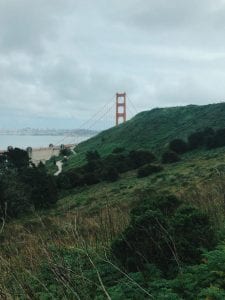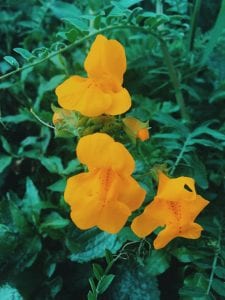On March 28th, our botany class visited Marin Headlands. The Marin Headlands is a hilly peninsula at the southernmost edge of Marin County. The trail we walked along consisted primarily of coastal scrub and was home to many beautiful wildflowers, such as the California poppy, the harlequin lily, the Franciscan paintbrush, etc. The Marin Headlands also is home to a diversity of wildlife such as coyotes, deers, and bobcats. 
Baby blue eyes (Nemophila menziesii) is an annual herb belonging to the Boraginaceae family. It is native to western North America and grows in a variety of habitats such as chaparral and grassland. The leaves of the flower are lobed and appear to be 3-ranked. The flowers are bisexual and radially symmetrical – its petals are white with blue veins and dots originating from the base of the petals. Although this flower was primarily white, the flowers of other individuals of this species are often more blue in color with a white center.
The Franciscan paintbrush (Castilleja subinclasa) is a perennial herb belonging to the Orobanchaceae family. This plant is endemic to the coastlines within the San Francisco Bay Area. Like many members of the Orobanchaceae family, the Franciscan paintbrush is hemi-parasitic – it is a root parasite that robs water and nutrients from the roots of host plants through haustoria that project from its roots. The leaves are primarily linear in shape and are alternately arranged. The flower clusters are arranged in a raceme inflorescence. The leaf-like bracts of the Franciscan paintbrush are the most prominent parts of the plant with a bright orange-red color. The flowers themselves are portruding, yellow-green in color, and pubescent. Additionally, the Franciscan paintbrush often grows on slopes.
The fringe cups (Tellima grandiflora) is a perennial herb belonging to the Saxifragaceae family. This plant is native to western North America and prefers to grow in moist forests and on slopes. The fringe cups have both basal and cauline leaves – its cauline leaves are sessile and its basal leaves are larger in size. In general, the leaves are palmately lobed, dissected, and slightly dentate. The stem is pubescent. The flowers are arranged in a spike-like raceme inflorescence and are attached to the stem by pedicels. The individual flowers consist of 10 stamens, 2 pistils, and 5 deeply fringed petals (giving it its name).
Trip Summary: At first, the cloudy and somewhat ominous weather was a good representation of our collective mood heading into the field quiz. Luckily it didn’t rain but there were a few close calls with the wind nearly sweeping my quiz away. Once the field quiz was finished, I was able to actually appreciate the beautiful view of the Golden Gate Bridge and didn’t mind the weather as much! Despite the anxiety surrounding the field quiz, there are definitely worse places to take an exam than surrounded by beautiful wildflowers and scenery in the Marin Headlands.
Honorable Mention Species







